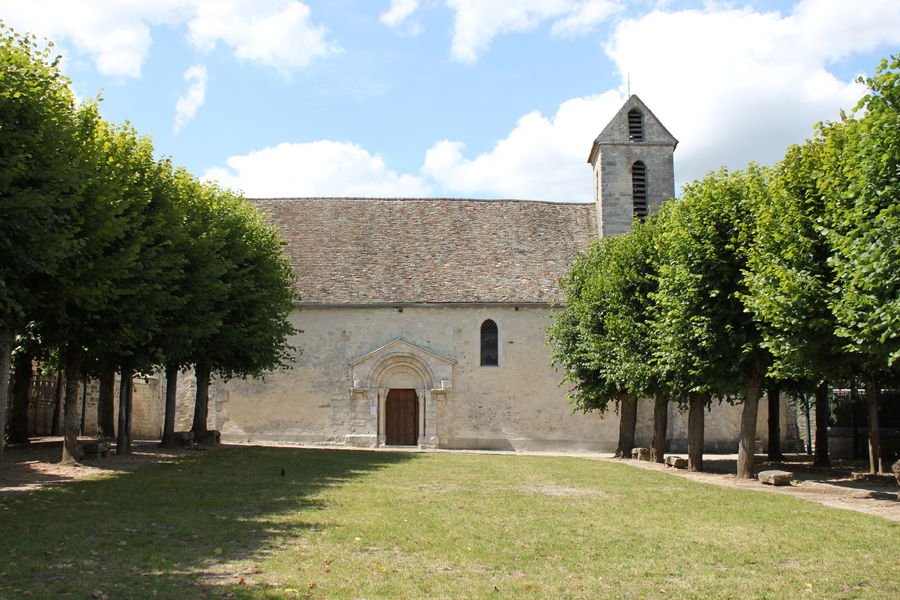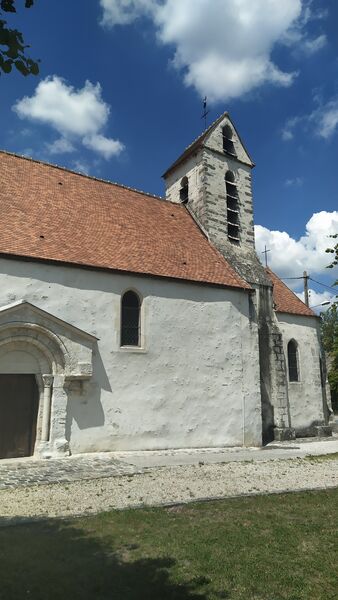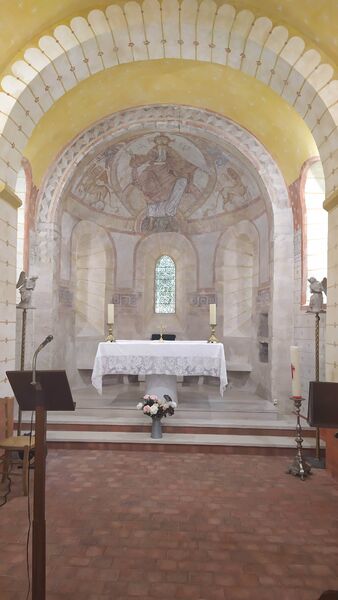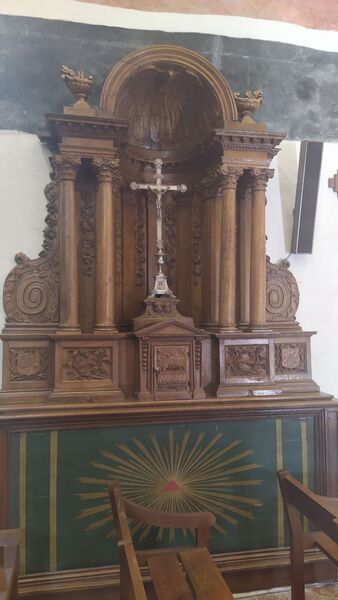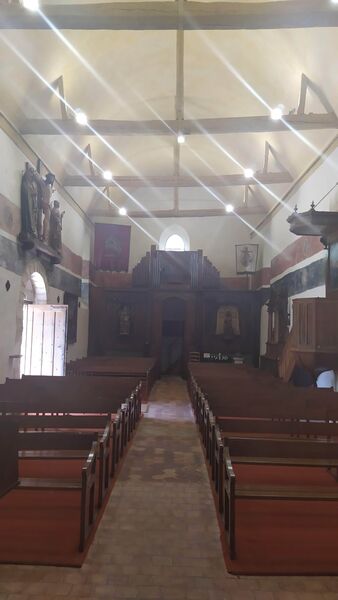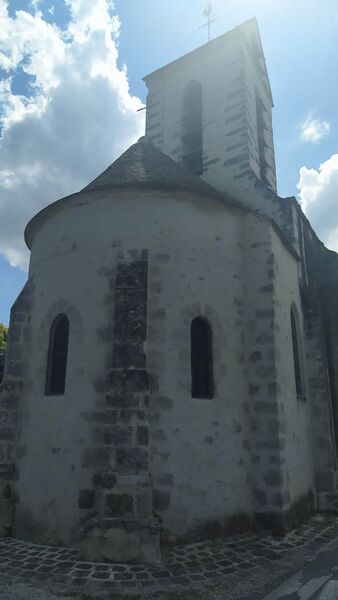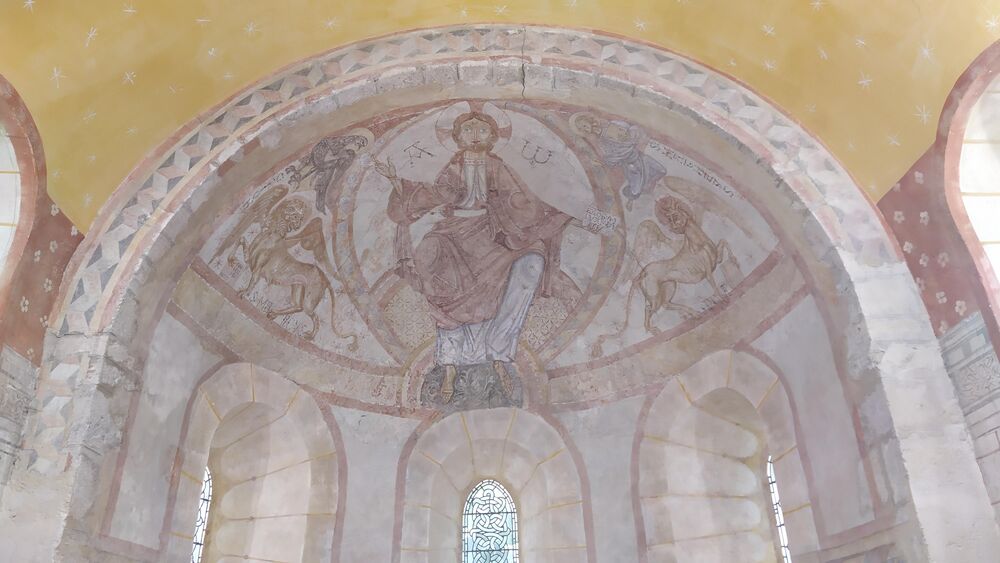Saint-Martin Church
Oncy-sur-École
Patrimoine_culturel
The church of Oncy was built during the 12th century and possesses a very rich heritage inside and outside that helps us to follow its history throughout ages.
The church of Oncy-sur-École was built at the end of the 11th century and at the beginning of the 12th century, at the same time as the priory. It is mostly of Roman style, which is not very common in the Gâtinais. Its bell tower is standing on a wider span, which is quite rare too. The nave is newer and was built during the 15th century. The beautiful portal made of wood was also built at this time. The Renaissance style lock is still in perfect condition and can still be used. During some recent restorations, different old foundations were found. The bell tower is quite simple and two-sloped. The shape of the church is very original as the bell tower is way narrower than the span.
On the South facade of the church, the traces of an old door can be seen. Inside, the traces of the now disappeared frame are clearly visible. This old door from the 11th century was opened once again during some works in 1965. During the restoration of the church in 2015, on the North side of it, some traces of an old dead’s portal was found. Indeed, between the 12th and 18th centuries, coffins had to leave the church by another door than the living.
The church of Oncy has two litera funeris, one is red and the other is black. It is quite rare to see some in churches. In the past, those litera funeris were colourful lines painted in order to honour some important persons’ death inside of churches. The big painting in the apse was restored in 1965 and is a representation of Jesus surrounded by some symbols of the evangelists.
The majority of the furniture is from the 17th century. Two statues are from the 13th century : Virgin Mary with Jesus and Sainte Anne which are both classified as part of the Monuments Historiques, like a painting of Saint-Sébastien and Sainte-Julienne. Two tombstones can be seen inside the church, one of them is supposed to be the grave of the legendary Father Soubise who created a French organization for craftsmen.
The church of Oncy is dedicated to Saint-Martin de Tours (Saint Martin) also known under the name of Martin le Miséricordieux. He was from Szombathely (also known as Savaria during the Roman Empire) in Hungary and he is one of the most famous and prayed saints in the whole world. He is one of the secondary patron saints in France. He was born in a military family and despite his wish to be religious, Martin became a military. The most famous part of his legend is when one night, as a legionnaire near Amiens, he tore up his coat to give half of it to a frozen poor man. As a person who was part of the army, he was not allowed to become an ecclesiastical. However, the people of Tours wanted him as their bishop so they kidnapped him and named him as bishop without his consent. He founded several abbeys and parishes all along the Loire Valley. He died of old age near Tours and was buried at the place of the basilica Saint-Martin de Tours. A recreation of his sarcophagus can be seen in the crypt.
SOURCE: Mairie de Oncy-sur-École, “Le Patrimoine Religieux de Milly-la-Forêt et de la Communauté de Communes des 2 Vallées” des Amis de Milly-en-Gâtinais et Environs, Parc Naturel Régional du Gâtinais Français
On the South facade of the church, the traces of an old door can be seen. Inside, the traces of the now disappeared frame are clearly visible. This old door from the 11th century was opened once again during some works in 1965. During the restoration of the church in 2015, on the North side of it, some traces of an old dead’s portal was found. Indeed, between the 12th and 18th centuries, coffins had to leave the church by another door than the living.
The church of Oncy has two litera funeris, one is red and the other is black. It is quite rare to see some in churches. In the past, those litera funeris were colourful lines painted in order to honour some important persons’ death inside of churches. The big painting in the apse was restored in 1965 and is a representation of Jesus surrounded by some symbols of the evangelists.
The majority of the furniture is from the 17th century. Two statues are from the 13th century : Virgin Mary with Jesus and Sainte Anne which are both classified as part of the Monuments Historiques, like a painting of Saint-Sébastien and Sainte-Julienne. Two tombstones can be seen inside the church, one of them is supposed to be the grave of the legendary Father Soubise who created a French organization for craftsmen.
The church of Oncy is dedicated to Saint-Martin de Tours (Saint Martin) also known under the name of Martin le Miséricordieux. He was from Szombathely (also known as Savaria during the Roman Empire) in Hungary and he is one of the most famous and prayed saints in the whole world. He is one of the secondary patron saints in France. He was born in a military family and despite his wish to be religious, Martin became a military. The most famous part of his legend is when one night, as a legionnaire near Amiens, he tore up his coat to give half of it to a frozen poor man. As a person who was part of the army, he was not allowed to become an ecclesiastical. However, the people of Tours wanted him as their bishop so they kidnapped him and named him as bishop without his consent. He founded several abbeys and parishes all along the Loire Valley. He died of old age near Tours and was buried at the place of the basilica Saint-Martin de Tours. A recreation of his sarcophagus can be seen in the crypt.
SOURCE: Mairie de Oncy-sur-École, “Le Patrimoine Religieux de Milly-la-Forêt et de la Communauté de Communes des 2 Vallées” des Amis de Milly-en-Gâtinais et Environs, Parc Naturel Régional du Gâtinais Français
Prestations, conforts et services
- French
Opening times
From 01/01 to 31/12, daily.


